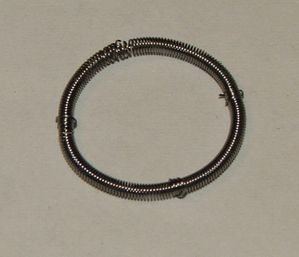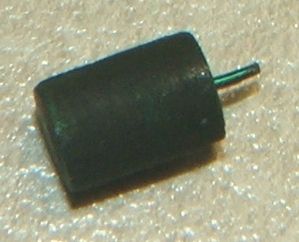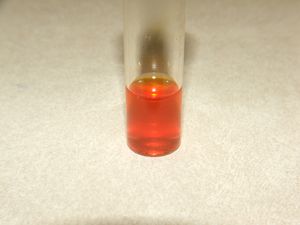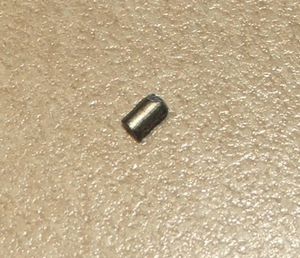Most metal carbonates decompose when heated. Their decomposition products vary between metals.
Sodium and other alkali metal carbonates: I heated sodium carbonate to a red heat and it did not decompose. These carbonates are extremely stable and do not decompose at an ordinary temperature.
Calcium and other alkaline earth metal carbonates (except beryllium): When heated strongly (840 C for calcium), magnesium, calcium, and strontium carbonates decompose into the oxide. The production of lime (calcium oxide) from limestone (calcium carbonate) has been a well known process for many years. Barium carbonate may form the peroxide when heated strongly. Beryllium does not form a carbonate.
Trivalent carbonates: Aluminium and its neighbors do not form carbonates. Scandium and the rare earth metals form carbonates. When heated vigorously, they decompose to the oxide.
Tetravalent or higher carbonates: The carbonates of Group 4, 5, and 7 do not exist.
Cobalt(II) carbonate: This easily decomposes to black cobalt(II,III) oxide, glowing red-hot as it is calcined. The resulting product is slightly soluble in hydrochloric acid, releasing no significant quantity of chlorine gas. Upon evaporation, a tiny crop of cobalt(II) chloride crystals is visible.
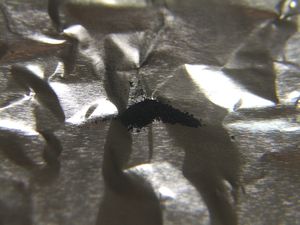
Copper(II) carbonate: This easily decomposes to black copper(II) oxide. Calcining does not occur at the low decomposition temperature, making the resulting oxide quite soluble in hydrochloric acid and useful for thermites and other metal oxide reactions.
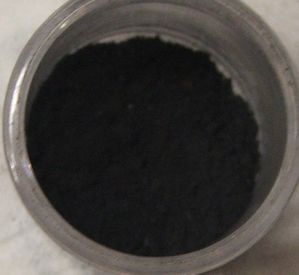
Zinc carbonate: This white substance decomposes to white zinc oxide, which reversibly turns light yellow when heated. The change in color is due to a loss of a few oxygen atoms.
Manganese carbonate: White manganese(II) carbonate decomposes when heated in air to a higher oxide of manganese such as manganese(III) oxide or manganosic oxide. This oxide forms a mud brown suspension in hydrochloric acid which slowly gives off chlorine gas at room temperature to form manganese(II) chloride. A little bit of the white carbonate is still visible in the picture below. In a vacuum, manganese(II) carbonate decomposes to green manganese(II) oxide.
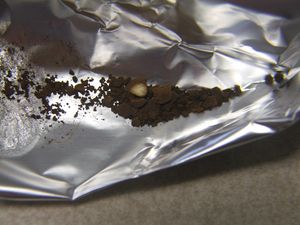
Iron(II) carbonate: White iron(II) carbonate decomposes without heating in air to iron(III) oxide and carbon dioxide gas. Since it does not have any excess acid like Mohr's salt, it is very sensitive to aerial oxidation. Addition of hydrochloric acid to a completely dry (and orange brown) precipitate of "iron(II) carbonate" produces no carbon dioxide gas, showing that a chemical reaction has occurred.
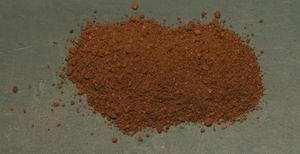
Nickel(II) carbonate: Nickel(II) carbonate, a green solid, decomposes at a moderate temperature to green stoichiometric nickel(II) oxide, which is soluble in HCl. When heated strongly (600 C), it turns black as it oxidizes further to non-stoichiometric nickel oxide. This nickel oxide has a formula (this is just armchair speculation based on experimental results) of NiO1+x where x is about 0.3. When heated strongly, the surface of the nickel oxide particles become further oxidized, reaching a formula of either Ni2O3 or NiO2. When placed in hydrochloric acid, the surface instantly dissolves, producing chlorine gas much more vigorously than with manganese dioxide. The inside portion dissolves slowly in hydrochloric acid, just like an ordinary calcined nickel oxide. Here is the black nickel oxide.
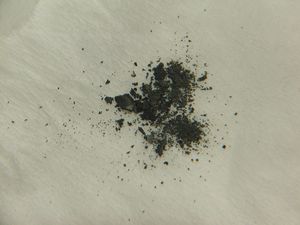
Lead(II) carbonate: Lead carbonate decomposes to lead(II) oxide, which is light orange - brown. The white lead carbonate is visible beside the orange lead oxide.
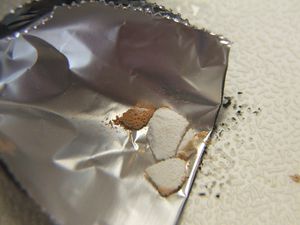
Silver(I) carbonate: This light yellow compound decomposes to dark brown silver(I) oxide at 210 C, which ultimately decomposes to black silver metal at 280 C.
Gadolinium(III) carbonate: This pale yellow solid decomposes to white gadolinium(III) oxide when heated.


